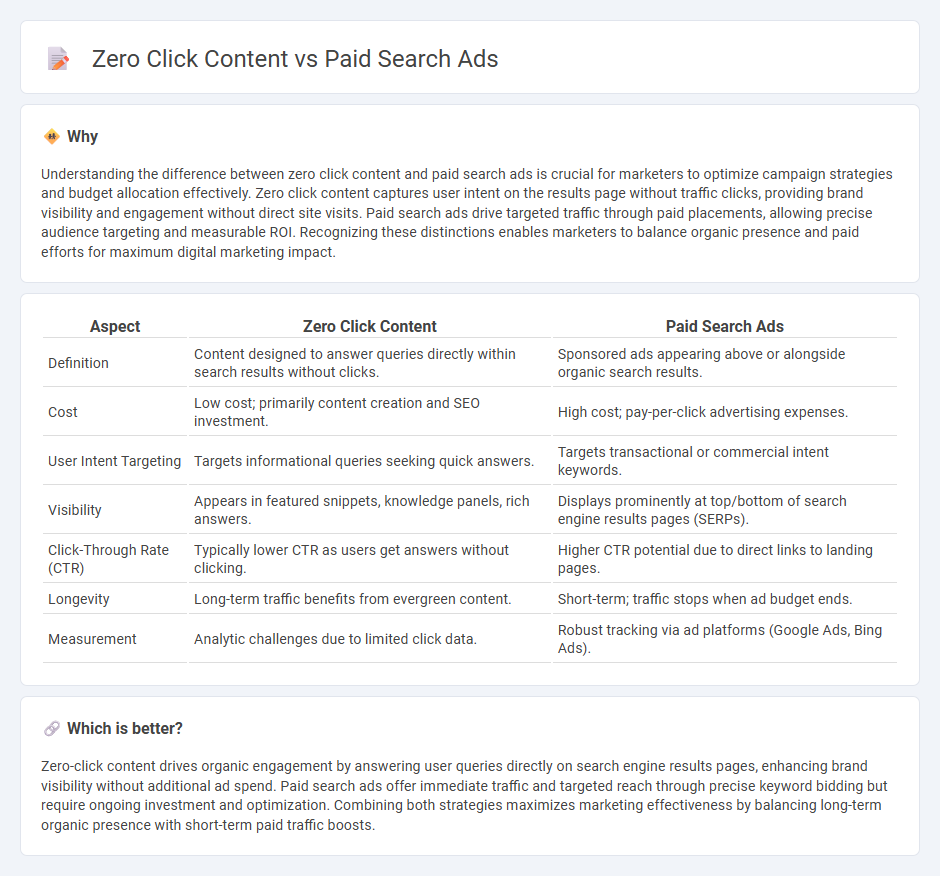
Zero click content drives organic engagement by providing instant answers directly on search engine results pages, reducing the need for users to click through to websites. Paid search ads leverage targeted keywords and bidding strategies to secure prominent placement and attract immediate traffic with measurable ROI. Explore deeper insights to optimize your marketing strategy by balancing zero click content and paid search investments.
Why it is important
Understanding the difference between zero click content and paid search ads is crucial for marketers to optimize campaign strategies and budget allocation effectively. Zero click content captures user intent on the results page without traffic clicks, providing brand visibility and engagement without direct site visits. Paid search ads drive targeted traffic through paid placements, allowing precise audience targeting and measurable ROI. Recognizing these distinctions enables marketers to balance organic presence and paid efforts for maximum digital marketing impact.
Comparison Table
| Aspect | Zero Click Content | Paid Search Ads |
|---|---|---|
| Definition | Content designed to answer queries directly within search results without clicks. | Sponsored ads appearing above or alongside organic search results. |
| Cost | Low cost; primarily content creation and SEO investment. | High cost; pay-per-click advertising expenses. |
| User Intent Targeting | Targets informational queries seeking quick answers. | Targets transactional or commercial intent keywords. |
| Visibility | Appears in featured snippets, knowledge panels, rich answers. | Displays prominently at top/bottom of search engine results pages (SERPs). |
| Click-Through Rate (CTR) | Typically lower CTR as users get answers without clicking. | Higher CTR potential due to direct links to landing pages. |
| Longevity | Long-term traffic benefits from evergreen content. | Short-term; traffic stops when ad budget ends. |
| Measurement | Analytic challenges due to limited click data. | Robust tracking via ad platforms (Google Ads, Bing Ads). |
Which is better?
Zero-click content drives organic engagement by answering user queries directly on search engine results pages, enhancing brand visibility without additional ad spend. Paid search ads offer immediate traffic and targeted reach through precise keyword bidding but require ongoing investment and optimization. Combining both strategies maximizes marketing effectiveness by balancing long-term organic presence with short-term paid traffic boosts.
Connection
Zero-click content and paid search ads are interconnected through their shared goal of maximizing visibility on search engine results pages (SERPs). Zero-click content delivers instant answers or information directly within the SERP, reducing the need for users to click through to websites, while paid search ads compete for prime real estate to capture user attention immediately. Marketers integrate both strategies to dominate SERP real estate, increasing brand exposure and driving conversions even when organic clicks are limited.
Key Terms
Cost Per Click (CPC)
Paid search ads typically incur a direct Cost Per Click (CPC), making budget management more predictable with precise targeting options on platforms like Google Ads. Zero click content, on the other hand, drives organic visibility and engagement without CPC but requires investment in SEO and content strategy for sustained traffic and brand authority. Explore the nuances between paid and organic strategies to optimize your marketing ROI effectively.
Search Engine Results Page (SERP)
Paid search ads appear prominently on the Search Engine Results Page (SERP), driving targeted traffic through cost-per-click (CPC) models and ensuring immediate visibility for advertisers. Zero-click content, such as featured snippets, knowledge panels, and rich answers, captures user attention directly on the SERP without requiring clicks, focusing on providing instant information and reducing the need for users to visit external websites. Explore how balancing paid search ads with zero-click content strategies can maximize your online presence and search engine marketing returns.
Click-Through Rate (CTR)
Paid search ads typically achieve higher Click-Through Rates (CTR) due to targeted keywords and compelling ad copy driving user engagement. Zero click content, while valuable for brand awareness and SEO, often results in lower CTR as users find answers directly on search engine results pages without clicking further. Explore strategies to optimize both paid ads and zero click content for maximum digital marketing impact.
Source and External Links
What Is Paid Search? - Coursera - Paid search is a method where businesses pay search engines for ads that appear on search engine results pages (SERPs), and advertisers pay a fee each time a user clicks on their ad, known as pay-per-click (PPC) advertising.
What is Paid Search? Marketing & Advertising Strategies - Sprinklr - Paid search advertising allows companies to bid on keywords to place ads higher on relevant SERPs to drive online traffic, paying only when users click their ads, with placement determined by bidding, ad quality, and relevance.
5 Paid Search Examples (Plus 3 Types of Search Ads to Know) - WebFX - There are three main types of paid search ads: traditional PPC text ads, Google Shopping ads featuring product images and prices, and Google Local Services ads, which charge advertisers only when contacted by potential customers.
 dowidth.com
dowidth.com